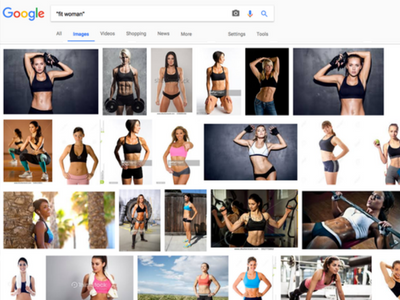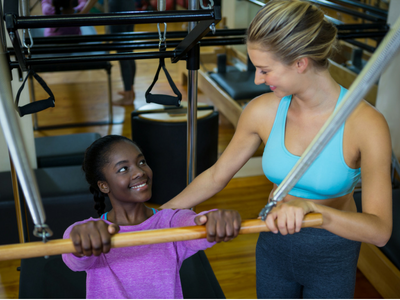Many of us see fitness as a luxury, and as something that may or may not be affordable to most. As a Black woman, I saw it for a long time as something that only white people could afford.
All of the gyms and studios that I knew of had a large majority of white staff and white clients. If I searched online for a particular gym, I would rarely if ever see pictures of anyone who looked like me. Even though I knew intuitively that “white“ was the default, those images told me that I, as a Black woman, was not the demographic they were marketing to.
What this perpetuates is a general consensus according to which Black people and people of color (POC) do not have enough money to afford luxurious gyms, studios and spas.
As a fitness professional, how you market your services and the images you use are very telling of who you will attract — or rather who you want to attract.
Who Are You Marketing To?
The marketing materials of the studios and gyms I’ve worked for rarely if ever have any Black/POC represented. When they do, it’s usually a single racially ambiguous person.
 While in recent years, some of the larger gyms have added more color to their marketing campaigns and their group fitness management teams, management positions above that still remain very white.
While in recent years, some of the larger gyms have added more color to their marketing campaigns and their group fitness management teams, management positions above that still remain very white.
Google searches for fitness, pilates and personal training imagery result in pictures of very predominantly white folk. As discussed in my previous article titled Let’s Talk about the Lack of Black Female Representation in Fitness, if the default images are white then does that mean that Black/POC are not a targeted market?
A Few Examples
During my employment at the Harlem YMCA, for example, marketing materials specifically included Black/POC. However, in the YMCAs elsewhere in town, not so much. As a potential client, member or employee, I’d assume that I am not being targeted.
 I teach Pilates, and the vast majority of studios where I work use images of white women as both teachers and students. My studio clientele is primarily comprised of white females, with a large percentage of the staff being white females as well. The only times when I’ve seen non-white representation in market plans has been when the owner was Black/POC — and even so, they tend to use the same white images in their marketing as well.
I teach Pilates, and the vast majority of studios where I work use images of white women as both teachers and students. My studio clientele is primarily comprised of white females, with a large percentage of the staff being white females as well. The only times when I’ve seen non-white representation in market plans has been when the owner was Black/POC — and even so, they tend to use the same white images in their marketing as well.
Let’s look at another example which we will call “Telltale Fitness.” Owned by a white male in his mid-30s, Telltale Fitness is a functional gym with free weights, squat racks, battle ropes, kettlebells and rowing machines, which also offers private training as well as small group training. Out of a staff of seven trainers, only one is a person of color — a Black male — the rest being white males and one white female trainer.
Telltale Fitness is located in an urban area with a mix of several races, cultures and ethnicities. Their website includes class descriptions, pricing, etc., as well as pictures of the owner and trainers, along with several pictures of the classes and clients being trained. None of the pictures represent any Black/POC except for the one Black male trainer.
 Looking at this from a Black/POC point of view, my first thought is that we are not the target audience and therefore feel less welcome. If I were to join anyway, I would lean towards working with the trainer who looks like me to feel more comfortable. I would also gravitate mostly to his classes, just so I could have some feeling of community.
Looking at this from a Black/POC point of view, my first thought is that we are not the target audience and therefore feel less welcome. If I were to join anyway, I would lean towards working with the trainer who looks like me to feel more comfortable. I would also gravitate mostly to his classes, just so I could have some feeling of community.
This is just one more example where a business’s target audience is neither reflective of its community nor is it of the world in general.
While many businesses have now begun to incorporate an anti-racism plan to combat this — a slow process in and of itself — this hasn’t fully translated into the health, fitness and wellness industry yet. Beyond marketing, this is still very apparent in the many summits, workshops and retreats with predominantly white presenters and attendees.
What Is an Anti-Racism Plan?
Anti-racism includes beliefs, actions, movements, and policies adopted or developed in order to oppose racism.
According to the Anti-Racism Digital Library [1]:
“Anti-racism can be defined as some form of focused and sustained action, which includes intercultural, interfaith, multilingual and inter-abled (i.e., differently abled) communities with the intent to change a system or an institutional policy, practice, or procedure which has racist effects.”
By its nature, anti-racism tends to promote the view that racism is both pernicious and pervasive, and that systemic, structural and individual changes in political, economic, and social life are required to dismantle and end it.
Some Questions to Ask Yourself
How can health, fitness and wellness businesses reach a broader market beyond that of white folk? The first step is asking yourself these questions as a business owner:
- What has been your personal experience with other Black/POC? Have you dealt with your own white supremacy or privilege?
- Does your space only include those who look like you? Does your marketing only reflect white people? If so, why?
- How many of your staff members (if you have any) are Black/POC?
- Are the images you use only reflective of white people? Have you looked for images of Black/POC?
- Are your mission, class descriptions and staff examples of inclusion? Or do they appear very white on the surface?
What About Hip Hop Music?
I have personally been in some predominantly white CrossFit boxes, barbell clubs and gyms whose music selection was a bit of a concern. I get that hip hop music is a very popular choice: it has a strong beat, it’s catchy and memorable, and definitely easy to lift to. My concern is with the type of hip hop music played — especially when it contains misogynistic undertones and an overuse of derogatory words spoken within the Black community (i.e., the N-word).
How would you feel if the space in which you worked out played music that was derogatory against you? Can you see how problematic it may be to have white folk singing and rapping along in the presence of a Black/POC?
Music selection should be included in your anti-racism plan. I’m not saying that everything should be classical music, however your music selection be inclusive of everyone through a variety of styles.
By revamping who you address in your marketing, the images you use and the music you choose, you can create the space for Black/POC to find community, safety, representation and acceptance.
Reference
- Anti-Racism Digital Library, http://sacred.omeka.net/
Source Link – https://www.girlsgonestrong.com/blog/coaching-and-training/is-your-fitness-practice-as-inclusive-as-you-think-it-is/





